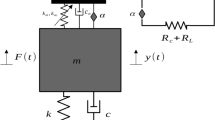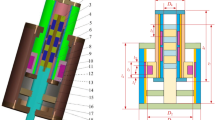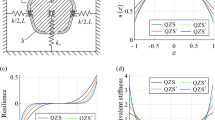Abstract
Changing magnetic flux in conductive materials will induce electric currents: if the change of flux is – somehow – related to mechanical motions, the corresponding kinetic energy of the mechanical system may be converted into electric energy. Thus, such inductive coupling offers highly flexible opportunities to remove energy from the mechanical system and either store or dissipate it in an electrical subsystem. Consequently, the corresponding mechanical force will act as a damping force. This basic effect is a classical means to calm structural vibrations: however, it is found that common approaches are very diverse and strongly differ in their basic mechanisms. The main aim of this contribution is to give an overview and classify the various approaches by emphasizing systematical differences as well as common points. In this sense, this contribution is intended to be a first step to pave the way for interconnected arrays of such devices. Therefore, the necessary basic functionalities to build an inductive damping element are surveyed and different topologies are built from these basic functionalities. The first part focuses on models based on magnetic circuits, where a change of the magnetic flux is achieved by the modulation of air gaps and thus, the magnetic reluctance of the circuit. The second part deals with an alternative design based on an eddy current damping element, that consists of a permanent magnet moving in a conductive tube. Beyond this basic configuration, the influence of kinematic modulations is explored by equipping this element with geometric discontinuities. Eventually, this offers manifold opportunities to design the dissipative behavior and thus, to smartly model the damping characteristic. After stating the equations of motion, a numerical analysis is inevitable. Partly Finite Element analysis is used for validation and to complement the analytic derivations.
Access this chapter
Tax calculation will be finalised at checkout
Purchases are for personal use only
Similar content being viewed by others
Notes
- 1.
The parameters used for the analysis are \(\kappa = 2\), \(\delta _0 = 1\), \(\beta = 10\), \(\rho _0 = 0.5\), \(\rho =0.5\), \(\gamma =0.5\), \(\nu = 1\), \(B_r = 1.2\).
- 2.
The parameters of the MEC are calculated by \(\Phi _R = A B_R\), \(R_\text {\textit{uc}}= \ell _{\text {\textit{uc}}}/(\mu _{\text {\textit{fe}}}A)\), \(R_\text {\textit{ic}}=\ell _\text {\textit{ic}}/(\mu _\text {\textit{fe}}A)\), \(R_m = \ell _m/(\mu _0 A)\), \(R_{d1} = (d_0-x)/(\mu _0 A)\), \(R_{d2}=(d_0+x)/(\mu _0 A)\), \(R_{\sigma 1} = \ell _{\sigma 1}/(\mu _0 \ell _{\sigma 1} b)\), \(R_{\sigma 2} = \ell _{\sigma 2}/(\mu _0 \ell _{\sigma 2} b)\). The values of the parameters used for the analysis are \(m={0.1}\,{\textrm{kg}}\), \(k={3\times {10}^{4}}\,{\textrm{N} \textrm{m}^{-1}}\), \(\hat{F}={1}\,{\textrm{N}}\) (force amplitude of excitation), \(R={0.015}\,{\Omega }\), \(d_0 = {3}\,{\textrm{mm}}\) (nominal air gap length), \(A={100}\,{\textrm{mm}^{2}}\), \(N=35\), \(B_R = {1.2}\,{\textrm{T}}\), \(\ell _\text {\textit{uc}}= {50}\,{\textrm{mm}}\), \(\ell _\text {\textit{ic}}={20}\,{\textrm{mm}}\), \(\ell _m = {2}\,{\textrm{mm}}\), \(\ell _{\sigma 1} = {4}\,{\textrm{mm}}\), \(\ell _{\sigma 2} = {13}\,{\textrm{mm}}\), \(b={10}\,{\textrm{mm}}\) (depth of iron core), \(\mu _0 = {4\pi \times 10^{-7}}\,{\textrm{H m}^{1}}\), \(\mu _{fe}=5000 \mu _0\).
References
Bae, J.-S., Hwang, J.-H., Park, J.-S., Kwag, D.-G.: Modeling and experiments on eddy current damping caused by a permanent magnet in a conductive tube. J. Mech. Sci. Technol. 23(11), 3024–3035 (2009)
Bae, J.-S., Hwang, J.-H., Roh, J.-H., Yi, M.-S.: Development of an electromagnetic shock absorber. Int. J. Appl. Electromag. Mech. 49(1), 157–167 (2015)
Bae, J.-S., Hwang, J.-H., Kwag, D.-G., Park, J., Inman, D.J.: Vibration suppression of a large beam structure using tuned mass damper and eddy current damping. Shock Vibr. 2014 (2014)
Behrens, S., Fleming, A.J., Reza Moheimani, S.O.: Electromagnetic shunt damping. In: Proceedings IEEE/ASME International Conference on Advanced Inteligent Mechatronics, pp. 1145–1150 (2003)
Laborenz, J., Siewert, C., Panning, L., Wallaschek, J., Gerber, C., Masserey, P.-A.: Eddy current damping: a concept study for steam turbine blading. J. Eng. Gas Turb. Power – Trans. ASME 132(5), 052505-1–052505-7 (2010)
Laborenz, J., Krack, M., Panning, L., Wallaschek, J., Denk, M., Masserey, P.-A.: Eddy current damper for turbine blading: electromagnetic finite element analysis and measurement results. J. Eng. Gas Turb. Power – Trans. ASME 134(4), 042504-1–042504-8 (2012)
Lian, J., Zhao, Y., Lian, C., Wang, H., Dong, X., Jiang, Q., Zhou, H., Jiang, J.: Application of an Eddy current-tuned mass damper to vibration mitigation of offshore wind turbines. Energies 11(12) (2018)
Prtybylowicz, P.M., Szmidt, T.: Electromagnetic damping of a mechanical harmonic oscillator with the effect of magnetic hysteresis. J. Theor. Appl. Mech. 47(2), 259–273 (2009)
Prtybylowicz, P.M., Szmidt, T.: Nonlinear response of a harmonically driven oscillator in magnetic field. Arch. Control Sci. 20(1), 19–30 (2010)
Rosenboom, M., Hetzler, H.: Damping based on electromagnetic induction: a comparison of different minimal models. In: Proceedings in Applied Mathematics and Mechanics, vol. 20, no. 1 (2021)
Rothwell, E.J., Cloud, M.J.: Electromagnetics. CRC Press LLC, Boca Raton (2001)
Sodano, H.A., Bae, J.-S., Inman, D.J., Belvin, W.K.: Concept and model of eddy current damper for vibrations supprsion of a beam. J. Sound Vibr. 288(4–5), 1177–1196 (2005)
Sodano, H.A., Bae, J.-S., Inman, D.J., Belvin, W.K.: Improved concept and model of Eddy current damper. J. Vibr. Acous. - Trans. ASME 128(3), 294–302 (2006)
Sodano, H.A., Inman, D.J.: Modeling of a new active eddy current vibration control system. J. Dyna. Syst. Measur. Control – Trans. ASME 130(2), 021009-1–021009-11 (2008)
Sudhoff, S.D.: Power Magnetic Devices. Wiley, Hoboken (2014)
Woodson, H.H., Melcher, J.R.: Electromechanical Dynamics - Part 1 Discrete Systems. Wiley, Hoboken (1968)
Author information
Authors and Affiliations
Corresponding author
Editor information
Editors and Affiliations
Rights and permissions
Copyright information
© 2024 The Author(s), under exclusive license to Springer Nature Switzerland AG
About this chapter
Cite this chapter
Rosenboom, M., Hetzler, H. (2024). A Systematic Approach to Smart Damping of Mechanical Systems Based on Inductive Electro-Mechanical Coupling. In: Eberhard, P. (eds) Calm, Smooth and Smart. Lecture Notes in Applied and Computational Mechanics, vol 102. Springer, Cham. https://doi.org/10.1007/978-3-031-36143-2_4
Download citation
DOI: https://doi.org/10.1007/978-3-031-36143-2_4
Published:
Publisher Name: Springer, Cham
Print ISBN: 978-3-031-36142-5
Online ISBN: 978-3-031-36143-2
eBook Packages: EngineeringEngineering (R0)




